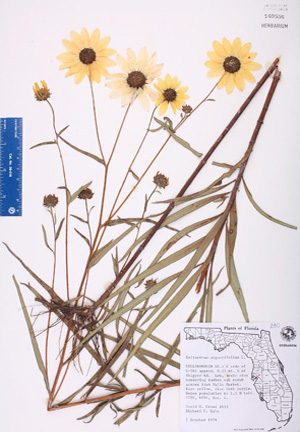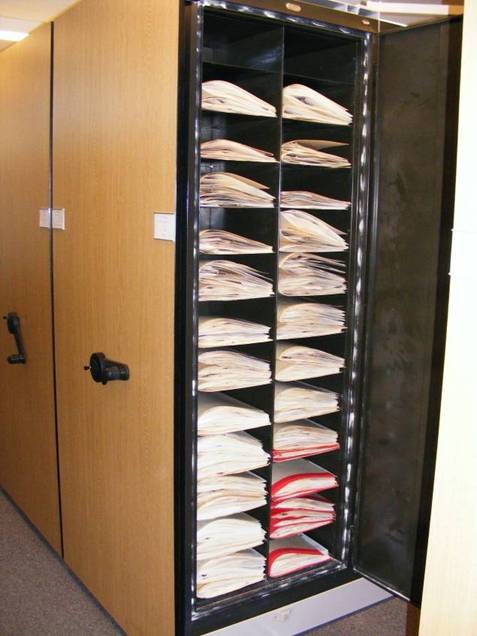Research
Herbarium

The USF Herbarium was established as a research and teaching collection in 1958, two years after the founding of the University of South Florida.
Location
The USF Herbarium is located in room 20 of the University of South Florida Tampa Library.
Please contact: spcinfo@usf.edu
Mailing Address:
USF Herbarium
University of South Florida
4202 E. Fowler Ave, LIB 122
Tampa, FL 33620
Website
Current research projects at The Herbarium include the Atlas of Florida Vascular Plants, monographs, and systematic studies.
Visiting
If you would like to visit the herbarium, please contact the Herbarium staff prior to your visit.
Collections
The USF Herbarium, with more than 270,000 specimens, is the second largest collection in Florida, the seventh largest in the southeastern United States, and ranks in the upper third of the world's herbaria in size.
Area of Taxonomic and Geographic Concentration
The collection consists of more than 250,000 specimens of vascular plants, 17,000 algae, and 2,000 bryophytes and lichens. The collection is richest in plants from Florida (40%), with strong holdings from North America north of Mexico (37%) and Latin America (13%). It has the largest collection in the world of materials from central and southern Florida. One important collection is the approximately 5,800 Orchidaceae, second only in the southeastern United States to the Marie Selby Botanical Gardens, an institution specializing in epiphytic plants (including Orchidaceae). Another significant collection is several thousand specimens from Nepal and Burma, an area not well represented in US Herbaria. Specific groups well represented include Apocynaceae, Arecaceae (palms), Begoniaceae, Bromeliaceae, Fabaceae (Leguminosae), and pteridophytes (ferns), these reflecting the primary research interests of the past and present staff. The collection contains more than 350 vascular plant type specimens.
Important Collections
Important collections include those of K. Burt-Utley, Edwin L. Bridges, G. R. Cooley, B. F. Hansen, R.K. Godfrey, R. Kral, J. M. Kunzer, O. Lakela, R. W. Long, Steve L. Orzell, J. D. Ray, Jr., J. Utley and R. P. Wunderlin.
Library
The Herbarium Library contains more than 10,000 books, reprints and journals, an extensive map collection, and a microfiche collection. The Library is open during most hours that the Herbarium is open. Although materials are not allowed to leave the Library, visitors are welcome to use the materials here. For more information, or to arrange a visit, please contact the Herbarium staff. The Herbarium Library holdings are listed in the USF Libraries Catalog.
Services
The Herbarium is available for use by qualified individuals. Specimens are available on loan to recognized botanical institutions engaged in taxonomic research. A plant identification operated in cooperation with The Institute for Systematic Botany (ISB) is provided to various companies, agencies, and individuals not part of USF and not involved in systematic research; contact B. Hansen or R. Wunderlin for more information. For further details regarding our use and loan policies, click here.
| Name | Phone | Research Interests |
|---|---|---|
| Diane Te Strake, Ph.D., Director | Fax: (813) 974-1614 |
|
| Alan R. Franck, Ph.D. |
flora and macrofungi of Florida and West Indies |
|
| Bruce F. Hansen, Ph.D. | (813) 974-6238 | Apocynaceae, flora of Florida |
| Kathleen Burt-Utley, Ph.D. | Begoniaceae | |
| Clinton J. Dawes, Ph.D. | (813) 974-2060 |
Physiological ecology and structure of seaweeds and seagrasses |
| Frederick B. Essig, Ph.D. | (813) 974-6234 | Palm flora of New Guinea, Clematis (Ranunculaceae), carnivorous plants |
| John Utley, Ph.D. | Bromeliaceae | |
| Richard P. Wunderlin, Ph.D. | (813) 974-2359 |
Bauhinia (Fabaceae), Cucurbitaceae, flora of Florida |

Researchers conducting projects specifically related to plant systematics are encouraged to use the collections. Initially, such researchers must contact the Director or Curator for permission to use the collections. Standard and common sense care for the specimens must be maintained at all times, including but not limited to the following:
- Persons working with the collection will be expected to fully understand its organization.
- Specimens must be properly re-filed. If there is any question about the positioning of material, it should be re-filed by herbarium personnel.
- Sheets are to be handled with care. Do not bend, break, or tear the sheets, and do not turn them face down.
- Under no circumstances is material to be removed from a specimen without permission. Permission is also required for dissection of plant parts.
- Loose plant pieces known to have detached from a particular sheet are to be placed in the associated fragment packet. If the sheet has no fragment packet, or is otherwise in need of repair, it should be brought to the attention of Herbarium personnel.
- Evidence of insect damage is to be reported at once.
- Investigators are encouraged to properly annotate the specimens. Annotations, in permanent ink or typewritten, should be made on labels of approximately 2.5 x 10 cm, and should bear, at least, the accepted name of the taxon, the name of the investigator, and the date (at least the year) of the identification.
Individuals not doing specific research work in plant taxonomy and wishing to take information from herbarium specimens will be allowed to do so on a limited basis under supervision and by appointment. Requests for supervised use of the collection will be evaluated on an individual basis.
Researchers intending to use the USF Herbarium for research are encouraged to include the use of the Herbarium in research grant proposals. Please consult with the Director before doing so.
Herbarium specimens are not to be removed from the premises without proper loan authorization and forms. Loans are made for one year to botanical institutions or departments engaged in taxonomic research. Ordinarily, loans are not made to individuals.
For instruction on preparing plant specimens, please visit The University of Florida's Herbarium Website.